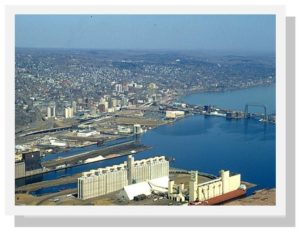 “A committee that actually gets work done”
“A committee that actually gets work done”
The HTAC is a working group for addressing challenges and opportunities in the Duluth-Superior harbor, while promoting the port’s economic and environmental importance to both communities.
It is one of three advisory committees to the Metropolitan Interstate Council (MIC), the federally designated Metropolitan Planning Organization (MPO) for the Duluth-Superior urbanized area.
And it is unique–the only stakeholder group of its kind in the country.
More important, it is, in the words of former Duluth Seaway Port Authority Director Adolf Ojard, “a committee that actually gets work done.”
Complexity, Controversy and Collaboration
Port-centered issues are usually complex, often controversial and sometimes downright contentious: dredged material management; marine safety; port security; land and recreational uses; economic development proposals; accelerated corrosion of maritime infrastructure; ballast water and invasive species management; legacy environmental degradation and habitat restoration initiatives –to name a few.
None of these problems affects one group alone, and none can be addressed except through the coordinated action of many diverse organizations and individuals. The HTAC has emerged as a national model for doing just that, through planning, collaboration, information sharing and long-term institutional involvement.
Its diverse members all hold a stake in the continued success and health of the harbor. Participation on the HTAC encourages representatives from industry, government, academic, environmental, regulatory and citizen groups on both sides of the bridge to recognize that although they have distinct missions they also have shared goals.
HTAC members, in other words, are genuine stakeholders who have, over its 20-year history, learned the value of playing nice and working hard together.
Result: a new paradigm for dredge material handling
 One recent example of the HTAC’s successful, collaborative planning process is what’s happening at Erie Pier. It might seem a little hard to get excited about this “hidden in plain sight” facility on the Duluth waterfront—but it represents an entirely new paradigm for dredge material handling.
One recent example of the HTAC’s successful, collaborative planning process is what’s happening at Erie Pier. It might seem a little hard to get excited about this “hidden in plain sight” facility on the Duluth waterfront—but it represents an entirely new paradigm for dredge material handling.
Thanks to the efforts of many HTAC members who undertook an intensive multi-year planning process, and to the US Army Corps of Engineers which subsequently agreed to make a significant investment in redesigning and re-engineering the facility, a major physical restructuring of the full-to-capacity Contained Disposal Facility at Erie Pier was undertaken to convert it to a Recycle-Reuse Facility. It utilizes hydraulic sorting to separate out the clean, uncontaminated sand and silt that’s dredged from the shipping channels for reuse in large-scale projects such as road construction and landfill cover.
The Duluth Seaway Port Authority now manages Erie Pier dredge materials as a valuable, re-usable resource instead of a waste product. By creating a cost effective and environmentally sound alternative to standard dredge material disposal practices, it will save local taxpayers the millions of dollars it would have cost to develop a new CDF.
Sincerest form of flattery
It also has the potential to change the way other Great Lakes ports manage their dredging operations. Erie Pier has recently gained the attention of the Canadian federal government, which is looking at the Erie Pier facility as a model for a new hydraulic sorting procedure at one or more of their dredging sites.
Most port communities face similar challenges. For this reason, we’ve been invited to present the HTAC model at many national-level planning and port conferences in recent years.
More Information/Get Involved
You can follow or participate in this notable initiative that’s happening right here in Duluth-Superior. For more information or to get on our meeting mailing list, check out the HTAC page on the MIC website at dsmic.org/htac.
Writing credit: Andy McDonald contributed to this article.
Photo credits:
Duluth-Superior Harbor aerial view – Gary Lidholm, USDA Forest Service, Superior National Forest
Erie Pier aerial view – Google Earth 2010


